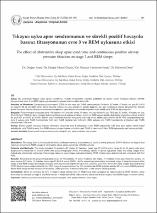Tıkayıcı uyku apne sendromunun ve sürekli pozitif havayolubasıncı titrasyonunun evre 3 ve REM uykusuna etkisi
Citation
Atan, D., Özcan, K. M., Kum Yurtsever, N., Dere, H. (2017). Tıkayıcı uyku apne sendromunun ve sürekli pozitif havayolubasıncı titrasyonunun evre 3 ve REM uykusuna etkisi. Kulak Burun Boğaz İhtisas Dergisi, 27(3), 141-145.Abstract
Amaç: Bu çalışmada tıkayıcı uyku apnesi sendromu (TUAS) hastalarında hastalık şiddetinin ve sürekli pozitif havayolu basıncı (SPHB) titrasyonunun evre 3 ve REM (rapid eye movement) uykusu üzerine etkisi araştırıldı.Hastalar ve Yöntemler: Çalışmaya polisomnografi (PSG) ile orta veya ağır TUAS tanısı konulan 114 hasta (87 erkek, 27 kadın, ort. yaş 51.1±10.5 yıl; dağılım 34-66 yıl) dahil edildi. Apne hipopne indeksi ve uyku evrelerinin yüzde değerleri ayrı ayrı istatistiksel olarak karşılaştırıldı. Sürekli pozitif havayolu basıncı titrasyonu sırasında hesaplanan uyku evrelerinin yüzde değerleri tespit edildi ve ilk PSG ile karşılaştırıldı.Bulgular: Polisomnografi sonucuna göre 114 hastanın 41'i orta (30 erkek, 11 kadın; ort. yaş 49.8±10.2 yıl), 73'ü ağır (57 erkek, 16 kadın; ort. yaş 51.8±10.8 yıl) TUAS idi. Apne hipopne indeksi arttıkça evre 2 uykusu artarken, evre 3 ve REM uykusu azaldı; değişimler istatistiksel olarak anlamlı idi (p<0.001, p=0.002, p=0.002). Sürekli pozitif havayolu basıncı titrasyonu sırasında tespit edilen uyku evreleri ile ilk PSG karşılaştırıldığında, evre 3 uykusu orta TUAS hastalarında %22, ağır TUAS hastalarında %45 arttı. REM uykusu orta TUAS hastalarında artmazken ağır TUAS hastalarında %28 arttı.Sonuç: Sürekli pozitif havayolu basıncı titrasyonu sırasında evre 3 uykusunda %40, REM uykusunda %20 artış geri tepme olarak kabul edildiğinde, orta TUAS'ta evre 3 ve REM uykusunda geri tepme olmazken ağır TUAS'ta hem evre 3 hem REM uykusunda geri tepme görüldü. Objectives: This study aims to investigate the effect of disease severity and continuous positive airway pressure (CPAP) titration on stage 3 and rapid eye movement (REM) sleeps in obstructive sleep apnea syndrome (OSAS) patients.Patients and Methods: The study included 114 patients (87 males, 27 females; mean age 51.1±10.5 years; range 34 to 66 years) who were diagnosed as moderate or severe OSAS with polysomnography (PSG). Percentage values of apnea hypopnea index and sleep stages were individually statistically compared. Percentage values of sleep stages calculated during CPAP titration were determined and compared with first PSG. Results: According to the polysomnography result, of 114 patients, 41 were moderate (30 males, 11 females; mean age 49.8±10.2 years), 73 were severe (57 males, 16 females; mean age 51.8±10.8 years) OSAS. As the apnea hypopnea index increased, stage 2 sleep increased, while stage 3 and REM sleeps decreased; changes were statistically significant (p<0.001, p=0.002, p=0.002). When the sleep stages detected during CPAP titration were compared to the first PSG, stage 3 sleep increased by 22% in moderate OSAS patients and by 45% in severe OSAS patients. While REM sleep did not increase in moderate OSAS patients, it increased by 28% in the severe OSAS patients.Conclusion: When an increase by 40% in stage 3 sleep and by 20% in REM sleep were accepted as rebound during CPAP titration, while there was no rebound at stage 3 and REM sleeps in moderate OSAS, rebound was observed at both stage 3 and REM sleeps in severe OSAS.
Source
Kulak Burun Boğaz İhtisas DergisiVolume
27Issue
3Collections
- Makale Koleksiyonu [524]
- TR-Dizin İndeksli Yayınlar Koleksiyonu [1602]


















